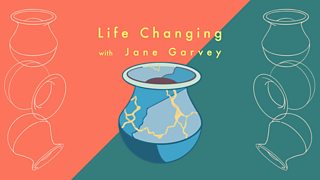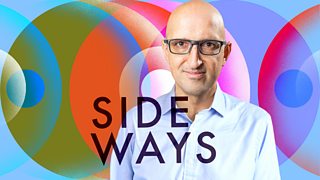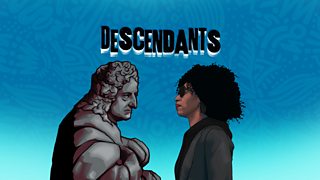Meet the man who really feels your pain

Usually, when we say “I feel your pain”, we mean it figuratively. We mean that we can empathise with someone in emotional distress; we understand them.
For US-based doctor Joel, however, the expression is entirely literal.
For as long as he can remember, he has been able to experience the pain and sensations being felt by those around him.
In Room 5 – a new series for Radio 4 – Helena Merriman meets those who, like her, have been given shocking and little-known medical diagnoses, to shine a light on these conditions. Here, we discover Joel’s story.

I am Bugs Bunny
Like many children, Joel spent much of his childhood sitting on the carpet in front of the television watching cartoons. But while most children would be watching and laughing at the misadventures of the carefree, carrot-munching Bugs Bunny, Joel was having a much more immersive experience. He recalls: “As I’m watching it, I am Bugs Bunny, as Bugs Bunny takes a bite of his carrot, I feel like I’m biting into a carrot and chewing it. I feel two big teeth on my lower lip, and two long ears.” It wasn’t just Bugs Bunny either, as Daffy Duck appeared, he felt as though he too had a bill in place of his mouth.

The social world felt cold
Television became somewhere to escape to for Joel, as he was bullied at school. He found being around the other children uncomfortable, as even when just watching them from the edge of the playground, he felt as though his body was playing and running around with them. He would dance and move around in response to these strange feelings. Inside the classroom he had a very particular way of working, writing colours and numbers in specific colours. Other children noticed this and picked on him, and school became a miserable place for Joel.
I assumed this was what everybody else was experiencing
Years later, Joel trained to become a doctor, inspired by the work of a shaman he had seen on a university trip to the Amazon rainforest in Brazil. Yet while medicine is a hugely challenging profession at the best of times, for Joel it was made infinitely harder by the fact he experiences the sensations of others. In a hospital setting, this can mean pain and discomfort. This goes as far as experiencing the cramping limbs of tetanus patients, the loss of those with amputations, or the physical sensation of being resuscitated while a person with cardiac arrest was administered CPR. At the time, Joel didn’t realise that others don’t experience their surroundings as he does: “Maybe I was just sensitive, maybe I was just very empathetic. I just took it as a given that this was me, I just noticed these things.”
I was struck by how ordinary it sounded
Joel went on a research trip to India and, one night in the compound, while enjoying cups of chai together, a neuroscientist colleague of his explained how some people “live in a constant state of an acid trip of some sort, because they see colours and shapes with sounds and music, and colours with letters and taste with sound.”
To many, this may sound extraordinary and fascinating, but to Joel this sounded very ordinary. Joel plucked up the courage to speak to his friend about it, explaining that he thought everyone perceived the world in that way. It was only then that Joel discovered his outlook was rare: “That was when I first heard the term for it, which was synaesthesia,” he reflects.
Mirror-touch synaesthesia
Synaesthesia is when our senses blend together. There are many types of synaesthesia: grapheme-colour synaesthesia, for instance, is where certain letters or numbers have specific colours associated with them; chromesthesia, experienced by many musicians, is where sounds evoke colours; and for some, sounds trigger the perception of textures or tastes.
So what caused Joel to feel the sensations of others; was this linked to synaesthesia? Joel visited a clinic in San Diego, run by a world expert in the condition, to find out. His synaesthesia was confirmed, and it was explained to him that it wasn’t normal to feel the physical sensations of others either, but that this had a name: mirror-touch synaesthesia. It is thought to be experienced by around 1.6 percent of the population.
If I go too deep, I might not be able to come back
Joel worried that if knowledge of his condition got out, it could influence others’ perceptions of him and jeopardise his career. Joel was a qualified medical doctor and was surrounded by people’s pain and discomfort daily. He became exhausted and resentful of the world around him. While working with patients of psychosis, Joel explains that “I just found myself getting lost in the experiences of these patients and slipping faster and faster down these corridors of thoughts and associations [...] It was never a fear of the patients, it was more a fear of my own mind.”
It was never a fear of the patients, it was more a fear of my own mind.
After in-depth research, Joel came across the work of Michael Banissy, a professor of Psychology at Goldsmiths, University of London, and an expert in mirror-touch synaesthesia, who had developed a way of diagnosing the condition. Joel went on to meet Michael at a conference and was invited to his lab.
Brain imaging evidence
Michael explains that there is a range of brain imaging evidence to corroborate the experiences of those with mirror-touch synaesthesia, as their mirror-touch networks show greater activity. On visiting Michael’s lab, Joel was given a cap called an EEG containing electrodes that would record his scalp’s electrical activity. He was then shown video footage of people being touched. Some weeks later, Joel received an email explaining that he “very, very clearly” had mirror-touch synaesthesia.
Finally, he had a diagnosis and felt able to publicly share his experiences.
Empathy burn out
Joel also discovered why he felt as though he’d been losing his sense of self. Those with the condition are less able to return their attention to themselves after engaging with others. While this can make them very empathetic, it can be deeply distressing and overwhelming to take on the pain of others. This can lead to burn out.
Michael explains that you really can have too much empathy, but he’s helped develop ways to help those in caring professions manage empathy burnout. Joel has since learnt techniques to help him shift his focus of attention, like concentrating on his own physical sensations.
Gaining some control over it has meant he can utilise his condition for good to help diagnose patients. Far from seeing his mirror-touch synaesthesia as a burden, as it once felt, Joel now has a more positive outlook: “It does really open up a whole world of possibilities. It’s a wonderful, wonderful gift.”
-
![]()
Room 5
‘I stare at my own reflection, trying to remind myself that I’m not dead.’ Joel never understood why he felt different to other people. A revelation sparks a journey for answers.

More to discover...
-
![]()
Room 5
One afternoon, Helena Merriman walked into a doctor's surgery and was given a shock diagnosis. In Room 5, she interviews people who – like her – were changed by a diagnosis.
-
![]()
Life Changing
Jane Garvey talks to remarkable people with extraordinary stories. She discovers the transformative moment that has reshaped their life in surprising ways.
-
![]()
Sideways
Best-selling author Matthew Syed explores the ideas that shape our lives with stories of seeing the world differently.
-
![]()
Descendants
Descendants looks into our lives and our pasts and asks how we are connected to slavery. And, in turn, who does that mean our lives are connected to?




